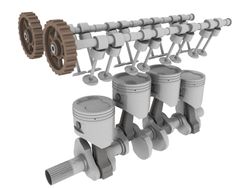Valvetrain
A traditional reciprocating internal combustion engine uses valves to to control air and fuel flow into and out of the cylinders, facilitating combustion. Valvetrain is an all-encompassing term used to described the mechanisms and parts which control the operation of the valves.
Layout
Valvetrains are built in several configurations, each of which varies slightly in layout but still performs the task of opening and closes the valves at the time necessary for proper operation of the engine. These layouts are differentiated by the location of the camshaft within the engine:
- Overhead camshaft
- The camshaft (or camshafts, depending on the design employed) is located above the valves within the cylinder head, and operates either indirectly or directly on the valves.
- Cam-in-block
- The camshaft is located within the engine block, and operates directly on the valves, or indirectly via pushrods and rocker arms. Because they often require pushrods they are often called pushrod engines.
- Camless
- This layout uses no camshafts at all. Technologies such as solenoids are used to individually actuate the valves.
Parts
As stated above, the valvetrain is the mechanical system responsible for operation of the valves. Valves are usually of the poppet type, although many others have been developed such as sleeve, slide and rotary valves.
Poppet valves typically require small coil springs, appropriately named valve springs, to keep them closed when not actuated by the camshaft. They are attached to the valve stem ends, seating within spring retainers. Other mechanisms can be used in place of valve springs to keep the valves closed: Formula 1 engines employ pneumatic cylinder heads in which fluid pressure closes the valves, while motorcycle manufacturer Ducati uses desmodromic mechanisms to manually close the valves.
Depending on the design used, the valves are actuated directly by a rocker arm, finger or bucket tappet. Overhead camshaft engines use fingers or bucket tappets, upon which the cam lobes contact, while cam-in-block engines use rocker arms. Rocker arms are actuated by a pushrod, and pivot on a shaft or individual ball studs in order to actuate the valves.
Pushrods are long, slender metal rods seated within the engine block. At the bottom ends the pushrods are fitted with lifters, either solid or hydraulic, upon which the camshaft, located within the cylinder block, makes contact. The camshaft pushes on the lifter, which pushes on the pushrod, which pushes on the rocker arm, which rotates and pushes down on the valve.
Camshafts must actuate the valves at the appropriate time in the combustion cycle. In order to accomplish this the camshaft is linked to and kept in synchronisation with the crankshaft (the main shaft upon which the pistons act) through the use of a metal chain, rubber belt or geartrain. Because these mechanisms are essential to the proper timing of valve actuation they are named timing chains, timing belts and timing gears, respectively.
